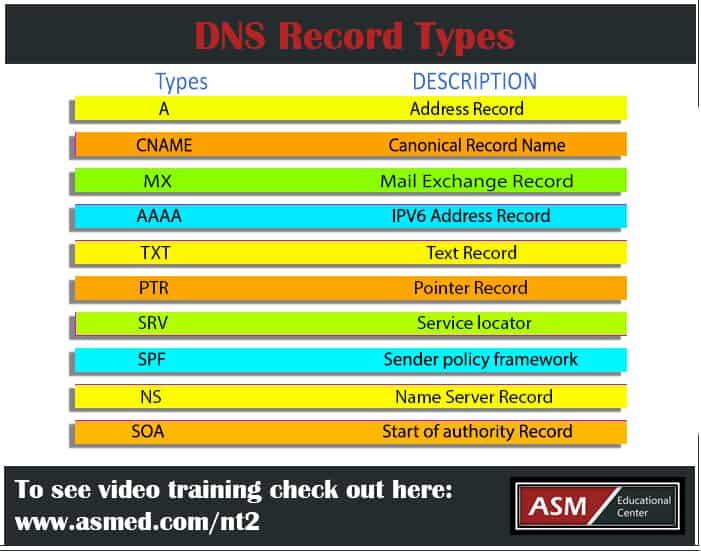CompTIA Network+ | Microsoft MTA Networking: DNS Records Types
From Wikipedia
Type |
Description |
Function |
| A | Address Record | Returns a 32-bit IPv4 address, most commonly used to map hostnames to an IP address of the host,but it is also used for DNSBLs, storing subnet masks in RFC 1101, etc. |
| CNAME | Canonical Name Record | Alias of one name to another: the DNS lookup will continue by retrying the lookup with the new name. |
| MX | Mail Exchange Record | Maps a domain name to a list of message transfer agents for that domain |
| AAAA | IPv6 Address Record | Returns a 128-bit IPv6 address, most commonly used to map hostnames to an IP address of the host. |
| TXT | Text Record | Originally for arbitrary human-readable text in a DNS record. Since the early 1990s, however, this record more often carriesmachine-readable data, such as specified by RFC 1464, opportunistic encryption, Sender Policy Framework, DKIM, DMARC, DNS-SD, etc. |
| PTR | Pointer Record | Pointer to a canonical name. Unlike a CNAME, DNS processing stops and just the name is returned. The most common use is for implementing reverse DNS lookups, but other uses include such things as DNS-SD. |
| SRV | Service locator | Generalized service location record, used for newer protocols instead of creating protocol-specific records such as MX. |
| SPF | Sender Policy Framework | SPF(99) (from RFC 4408) was specified as part of the Sender Policy Framework protocol as an alternative to storing SPF data in TXT records, using the same format. It was later found that the majority of SPF deployments lack proper support for this record type, and support for it was discontinued in RFC 7208. |
| NS | Name Server record | Delegates a DNS zone to use the given authoritative name servers |
| SOA | Start of [a zone of] Authority Record | Specifies authoritative information about a DNS zone, including the primary name server, the email of the domain administrator, the domain serial number, and several timers relating to refreshing the zone. |

Want more information on how to become CompTIA Network+ Certified? Learn more!
Also published on Medium.